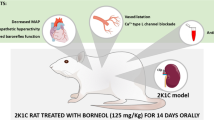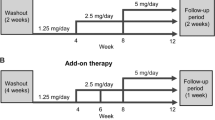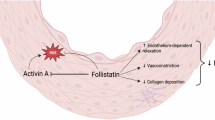Abstract
Aim:
To investigate the mechanisms underlying the vasorelaxant effect of formononetin, an O-methylated isoflavone, in isolated arteries, and its antihypertensive activity in vivo.
Methods:
Arterial rings of superior mesenteric arteries, renal arteries, cerebral basilar arteries, coronary arteries and abdominal aortas were prepared from SD rats. Isometric tension of the arterial rings was recorded using a myograph system. Arterial pressure was measured using tail-cuff method in spontaneously hypertensive rats.
Results:
Formononetin (1–300 μmol/L) elicited relaxation in arteries of the five regions that were pre-contracted by KCl (60 mmol/L), U46619 (1 μmol/L) or phenylephrine (10 μmol/L). The formononetin-induced relaxation was reduced by removal of endothelium or by pretreatment with L-NAME (100 μmol/L). Under conditions of endothelium denudation, formononetin (10, 30, and 100 μmol/L) inhibited the contraction induced by KCl and that induced by CaCl2 in Ca2+-free depolarized medium. In the absence of extracellular Ca2+, formononetin (10, 30, and 100 μmol/L) depressed the constriction caused by phenylephrine (10 μmol/L), but did not inhibit the tonic contraction in response to the addition of CaCl2 (2 mmol/L). The contraction caused by caffeine (30 mmol/L) was not inhibited by formononetin (100 μmol/L). Formononetin (10 and 100 μmol/L) reduced the change rate of Ca2+-fluorescence intensity in response to KCl (50 mmol/L). In spontaneously hypertensive rats, formononetin (5, 10, and 20 mg/kg) slowly lowered the systolic, diastolic and mean arterial pressure.
Conclusion:
Formononetin causes vasodilatation via two pathways: (1) endothelium-independent pathway, probably due to inhibition of voltage-dependent Ca2+ channels and intracellular Ca2+ release; and (2) endothelium-dependent pathway by releasing NO. Both the pathways may contribute to its antihypertensive effect.
Similar content being viewed by others
Log in or create a free account to read this content
Gain free access to this article, as well as selected content from this journal and more on nature.com
or
References
Ogihara T, Matsuzaki M, Matsuoka H, Shimamoto K, Shimada K, Rakugi H, et al. The combination therapy of hypertension to prevent cardiovascular events (COPE) trial: rationale and design. Hypertension Res 2005; 28: 331–8.
Yeh CT, Huang WH, Yen GC . Antihypertensive effects of Hsian-tsao and its active compound in spontaneously hypertensive rats. J Nutr Biochem 2009; 20: 866–75.
Kwan CY . Vascular effects of selected antihypertensive drugs derived from traditional medicinal herbs. Clin Exp Pharmacol Physiol Suppl 1995; 22: S297–9.
Ryu SY, Oh KS, Kim YS, Lee BH . Antihypertensive, vasorelaxant and inotropic effects of an ethanolic extract of the roots of Saururus chinensis. J Ethnopharmacol 2008; 118: 284–9.
Atkinson C, Compston JE, Day NE, Dowsett M, Bingham SA . The effects of phytoestrogen isoflavones on bone density in women: a double-blind, randomized, placebo-controlled trial. Am J Clin Nutr 2004; 79: 326–33.
Jarred RA, Keikha M, Dowling C, McPherson SJ, Clare AM, Husband AJ, et al. Induction of apoptosis in low to moderate-grade human prostate carcinoma by red clover-derived dietary isoflavones. Cancer Epidemiol Biomarkers Prev 2002; 11: 1689–96.
Nestel P, Fujii A, Zhang L . An isoflavone metabolite reduces arterial stiffness and blood pressure in overweight men and postmenopausal women. Atherosclerosis 2007; 192: 184–9.
Ososki AL, Kennelly EJ . Phytoestrogens: a review of the present state of research. Phytother Res 2003; 17: 845–69.
Wu JH, Li Q, Wu MY, Guo DJ, Chen HL, Chen SL, et al. Formononetin, an isoflavone, relaxes rat isolated aorta through endothelium-dependent and endothelium-independent pathways. J Nutr Biochem 2009; 21: 613–20.
Chin-Dusting JP, Boak L, Husband A, Nestel PJ . The isoflavone metabolite dehydroequol produces vasodilatation in human resistance arteries via a nitric oxide-dependent mechanism. Atherosclerosis 2004; 176: 45–8.
Adlercreutz H, Hamalainen E, Gorbach S, Goldin B . Dietary phyto-oestrogens and the menopause in Japan. Lancet 1992; 339: 1233.
Breinholt V, Hossaini A, Svendsen GW, Brouwer C, Nielsen E . Estrogenic activity of flavonoids in mice. The importance of estrogen receptor distribution, metabolism and bioavailability. Food Chem Toxicol 2000; 38: 555–64.
Reinli K, Block G . Phytoestrogen content of foods — a compendium of literature values. Nutr Cancer 1996; 26: 123–48.
Tham DM, Gardner CD, Haskell WL . Clinical review 97: potential health benefits of dietary phytoestrogens: a review of the clinical, epidemiological, and mechanistic evidence. J Clin Endocrinol Metab 1998; 83: 2223–35.
Chin-Dusting JP, Fisher LJ, Lewis TV, Piekarska A, Nestel PJ, Husband A . The vascular activity of some isoflavone metabolites: implications for a cardioprotective role. Br J Pharmacol 2001; 133: 595–605.
Walker HA, Dean TS, Sanders TA, Jackson G, Ritter JM, Chowienczyk PJ . The phytoestrogen genistein produces acute nitric oxide-dependent dilation of human forearm vasculature with similar potency to 17beta-estradiol. Circulation 2001; 103: 258–62.
Ma W, Nomura M, Takahashi-Nishioka T, Kobayashi S . Combined effects of fangchinoline from Stephania tetrandra Radix and formononetin and calycosin from Astragalus membranaceus Radix on hyperglycemia and hypoinsulinemia in streptozotocin-diabetic mice. Biol Pharm Bull 2007; 30: 2079–83.
Ma X, Tu P, Chen Y, Zhang T, Wei Y . Preparative isolation and purification of calycosin and formononetin from Astragalus membranaceus Bge var mongholicus (Bge) Hsiao by high-speed counter-current chromatography. Se Pu 2005; 23: 299–301.
Reiners W . 7-hydroxy-4′-methoxy-isoflavone (formononetin) from liquorice root. On substances contained in liquorice root. II. Experientia 1966; 22: 359.
Avula B, Wang YH, Smillie TJ, Khan IA . Quantitative determination of triterpenoids and formononetin in rhizomes of black cohosh (Actaea racemosa) and dietary supplements by using UPLC-UV/ELS detection and identification by UPLC-MS. Planta Med 2009; 75: 381–6.
Jiang B, Kronenberg F, Balick MJ, Kennelly EJ . Analysis of formononetin from black cohosh (Actaea racemosa). Phytomedicine 2006; 13: 477–86.
Schultz G . Isoflavone glucoside formononetin-7-glucoside and biochanin A-7-glucoside in Trifolium pratense L. Naturwissenschaften 1965; 52: 517.
Zhang BQ, Hu SJ, Qiu LH, Zhu JH, Xie XJ, Sun J, et al. Effects of Astragalus membranaceus and its main components on the acute phase endothelial dysfunction induced by homocysteine. Vasc Pharmacol 2007; 46: 278–85.
Adner M, Cantera L, Ehlert F, Nilsson L, Edvinsson L . Plasticity of contractile endothelin-B receptors in human arteries after organ culture. Br J Pharmacol 1996; 119: 1159–66.
Sandhu H, Xu CB, Edvinsson L . Upregulation of contractile endothelin type B receptors by lipid-soluble cigarette smoking particles in rat cerebral arteries via activation of MAPK. Toxicol Appl Pharmacol 2010; 249: 25–32.
Cao YX, Zheng JP, He JY, Li J, Xu CB, Edvinsson L . Induces vasodilatation of rat mesenteric artery in vitro mainly by inhibiting receptor-mediated Ca2+-influx and Ca2+-release. Arch Pharm Res 2005; 28: 709–15.
Cao YX, Zhang W, He JY, He LC, Xu CB . Ligustilide induces vasodilatation via inhibiting voltage dependent calcium channel and receptor-mediated Ca2+ influx and release. Vascul Pharmacol 2006; 45: 171–6.
Wiest R, Jurzik L, Moleda L, Froh M, Schnabl B, von Horsten S, et al. Enhanced Y1-receptor-mediated vasoconstrictive action of neuropeptide Y (NPY) in superior mesenteric arteries in portal hypertension. J Hepatol 2006; 44: 512–9.
Hashimoto T, Ohata H, Nobe K, Sakai Y, Honda K . A novel approach for the determination of contractile and calcium responses of the basilar artery employing real-time confocal laser microscopy. J Pharmacol Toxicol Methods 2007; 56: 79–86.
Nguyen P, Peltsch H, de Wit J, Crispo J, Ubriaco G, Eibl J, et al. Regulation of the phenylethanolamine N-methyltransferase gene in the adrenal gland of the spontaneous hypertensive rat. Neurosci Lett 2009; 461: 280–4.
Inc S . SPSS Base 13.0 for Windows: Users Guide 2004.
Broekaert A, Godfraind T . A comparison of the inhibitory effect of cinnarizine and papaverine on the noradrenaline- and calcium-evoked contraction of isolated rabbit aorta and mesenteric arteries. Eur J Pharmacol 1979; 53: 281–8.
Kawabata A, Nakaya Y, Ishiki T, Kubo S, Kuroda R, Sekiguchi F, et al. Receptor-activating peptides for PAR-1 and PAR-2 relax rat gastric artery via multiple mechanisms. Life Sci 2004; 75: 2689–702.
Bonaventura D, Oliveira FS, Lunardi CN, Vercesi JA, da Silva RS, Bendhack LM . Characterization of the mechanisms of action and nitric oxide species involved in the relaxation induced by the ruthenium complex. Nitric Oxide 2006; 15: 387–94.
Higueras J, Sarria B, Ortiz JL, Cortijo J, Maruenda A, Barbera M, et al. Halothane inhibits endothelium-dependent relaxation elicited by acetylcholine in human isolated pulmonary arteries. Eur J Pharmacol 1997; 326: 175–81.
Huang Y, Kwok KH . Beta-adrenoceptor-mediated relaxation inhibited by tetrapentylammonium ions in rat mesenteric artery. Life Sci 1998; 62: PL19–25.
Mustafa S, Thulesius O . Hyperthermia-induced vasoconstriction of the carotid artery and the role of potassium channels. J Stroke Cerebrovasc Dis 2005; 14: 122–6.
Figtree GA, Griffiths H, Lu YQ, Webb CM, MacLeod K, Collins P . Plant-derived estrogens relax coronary arteries in vitro by a calcium antagonistic mechanism. J Am Coll Cardiol 2000; 35: 1977–85.
Chan HY, Yao X, Tsang SY, Chan FL, Lau CW, Huang Y . Different role of endothelium/nitric oxide in 17beta-estradiol- and progesterone-induced relaxation in rat arteries. Life Sci 2001; 69: 1609–17.
Ford WR, Broadley KJ . Effects of adenosine receptor agonists on induction of contractions to phenylephrine of guinea-pig aorta mediated via intra- or extracellular calcium. Gen Pharmacol 1999; 33: 143–50.
Hirafuji M, Ebihara T, Kawahara F, Hamaue N, Endo T, Minami M . Inhibition by docosahexaenoic acid of receptor-mediated Ca2+ influx in rat vascular smooth muscle cells stimulated with 5-hydroxytryptamine. Eur J Pharmacol 2001; 427: 195–201.
Ajay M, Gilani AU, Mustafa MR . Effects of flavonoids on vascular smooth muscle of the isolated rat thoracic aorta. Life Sci 2003; 74: 603–12.
Leijten PA, van Breemen C . The effects of caffeine on the noradrenaline-sensitive calcium store in rabbit aorta. J Physiol 1984; 357: 327–39.
Mu H, Bai YH, Wang ST, Zhu ZM, Zhang YW . Research on antioxidant effects and estrogenic effect of formononetin from Trifolium pratense (red clover). Phytomedicine 2009; 16: 314–9.
Wang QY, Meng QH, Zhang ZT, Tian ZJ, Liu H . Synthesis, solubility, lipids-lowering and liver-protection activities of sulfonated formononetin. Yao Xue Xue Bao 2009; 44: 386–9.
Acknowledgements
This study was supported by grant from the National Natural Science Foundation of China (No 30772566).
Author information
Authors and Affiliations
Corresponding author
Rights and permissions
About this article
Cite this article
SUN, T., LIU, R. & CAO, Yx. Vasorelaxant and antihypertensive effects of formononetin through endothelium-dependent and -independent mechanisms. Acta Pharmacol Sin 32, 1009–1018 (2011). https://doi.org/10.1038/aps.2011.51
Received:
Accepted:
Published:
Issue date:
DOI: https://doi.org/10.1038/aps.2011.51
Keywords
This article is cited by
-
Synthesis of alkoxy-isoflavones as potential α-glucosidase inhibitors
Medicinal Chemistry Research (2022)
-
Endothelium-independent vasodilator effect of isocorynoxeine in vitro isolated from the hook of Uncaria rhynchophylla (Miquel)
Naunyn-Schmiedeberg's Archives of Pharmacology (2018)
-
Berberine inhibits enterovirus 71 replication by downregulating the MEK/ERK signaling pathway and autophagy
Virology Journal (2017)
-
Formononetin inhibits enterovirus 71 replication by regulating COX- 2/PGE2 expression
Virology Journal (2015)
-
Calycosin and formononetin from astragalus root enhance dimethylarginine dimethylaminohydrolase 2 and nitric oxide synthase expressions in Madin Darby Canine Kidney II cells
Journal of Natural Medicines (2013)



